Weekly Recap
U.S. stocks rose to a record high last week, before finishing the week modestly lower, with the Nasdaq holding up the best. Trade news dominated the headlines, although the market reaction was muted compared to the tariff announcements on April’s Liberation Day. Nvidia briefly reached the $4 trillion market capitalization level for the first time.
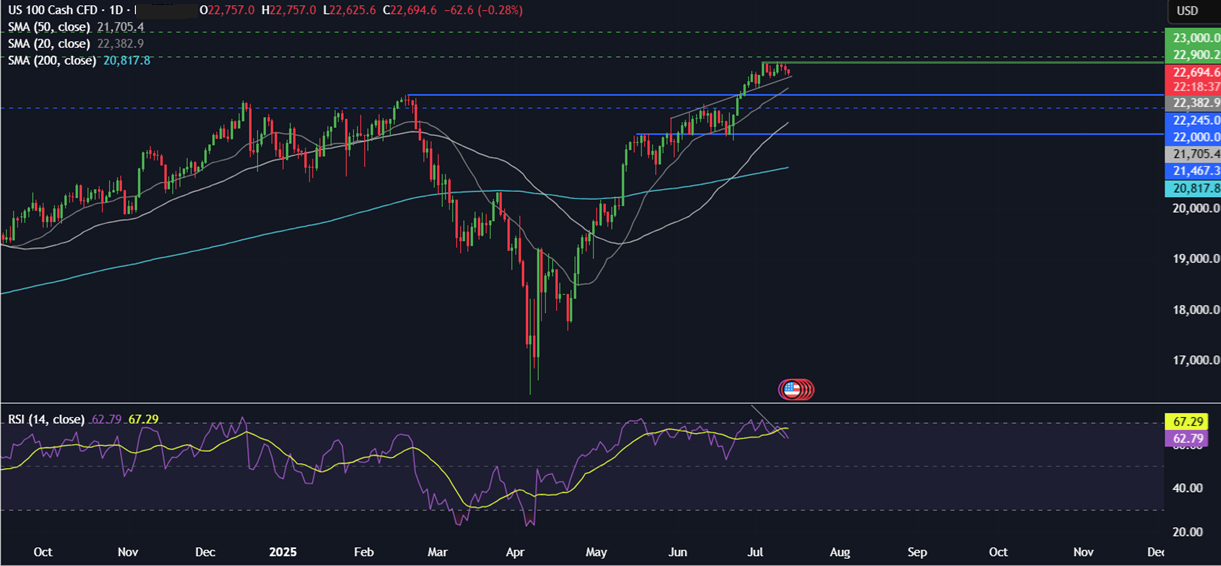
Trump announced 25% trade tariffs on major trading partners, including Japan and South Korea, as well as varying tariffs on other countries, including Canada, Thailand, and threatened to increase tariffs on imports from Brazil to 50%.
As well as country-specific tariffs, Trump announced a 50% tariff on copper, sending the US copper price to a record high.
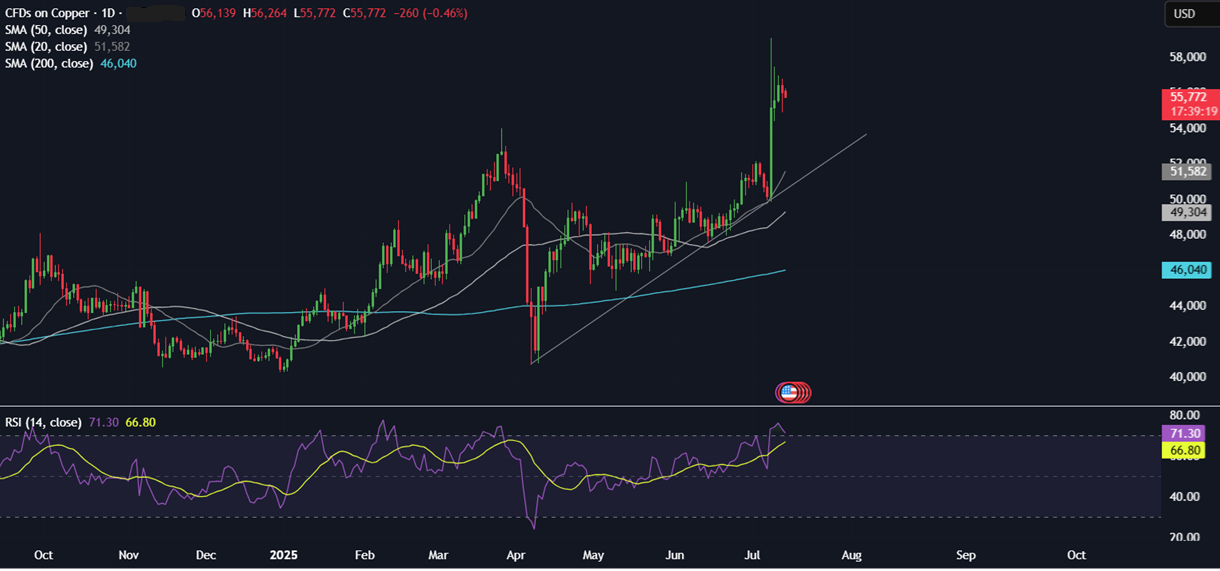
The minutes from the FOMC meeting showed increasing division among policymakers, with most expecting two rate cuts this year, some as early as July. However, some policymakers didn’t anticipate any rate cuts at all.
EU-US trade deal
Over the weekend, Trump announced 30% trade tariffs on the EU to start from August 1. The EU has said it will delay its plan to hit the US with retaliatory tariffs on €21 billion of US imports into the EU in the hope of coming to an agreement with Trump ahead of the August 1 deadline. The EU does not expect Trump to go through with the threat ultimately, but it is considered a negotiating tool. Negotiations between the two sides are reportedly advanced, and the market will be looking for a trade framework deal announcement soon, which could help the USD recover further from the 3.5-year low, pulling EUR/USD lower.
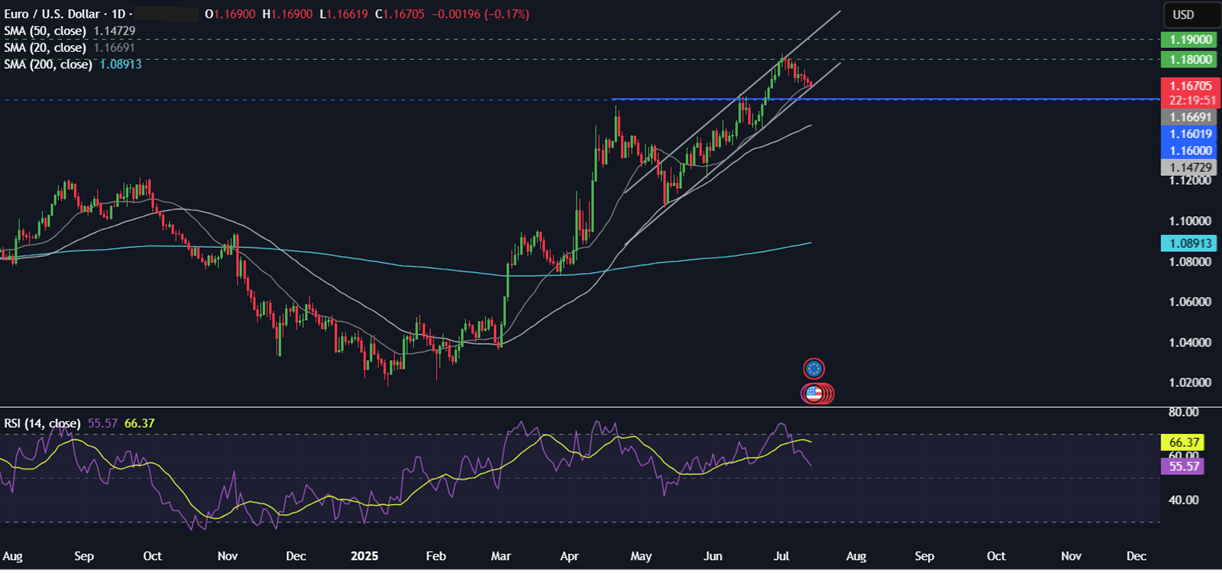
US CPI (Tuesday)
Expectations are for inflation to pick up modestly but not in a way that would concern the Fed at this stage. CPI is expected to rise 0.3% MoM, up from 0.1% in May. Core CPI is expected to rise to 0.3% up from 0.1%. The recent ISM surveys’ prices paid component is also showing signs of stickiness. Resilience in the US jobs market continues to suggest that the Fed has the luxury to remain cautious with regard to cutting interest rates further, even as President Trump has become increasingly vocal about the Fed’s need to cut rates. The recent FOMC minutes suggest that some policymakers see the hit to inflation from Trump’s tariffs as a one-off bump rather than a spike. Cooler-than-expected inflation could give stocks and gold a boost; however, stronger-than-expected inflation could start to raise concerns over tariff impacts on the US economy and unnerve investors.
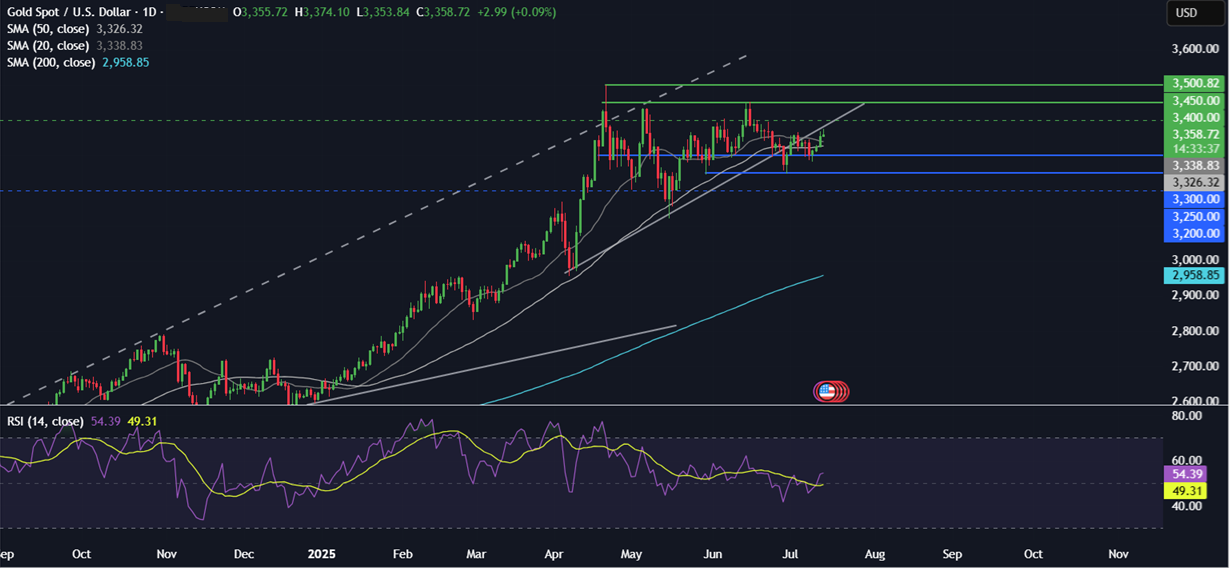
China Q2 GDP (Tuesday)
China will publish the bulk of its key economic indicators for June this week, with trade data out on Monday, which is expected to show a slight uptick in export and import growth on the month, early signs that there hasn’t been much front-loading activity during the tariff ceasefire. On Tuesday, Q2 GDP is expected to ease to 5.1% vs 5.4% in Q1, which would be broadly in line with the full year target. However, any weakness could unnerve the market and fuel expectations of more fiscal stimulus. The Chinese economy is expected to face pressure from external challenges and shocks across the second half of the year, and achieving the full-year growth target is unlikely to be easy and could require more targeted policy measures. Weaker-than-forecast growth could fuel stimulus bets and lift the Hang Seng.
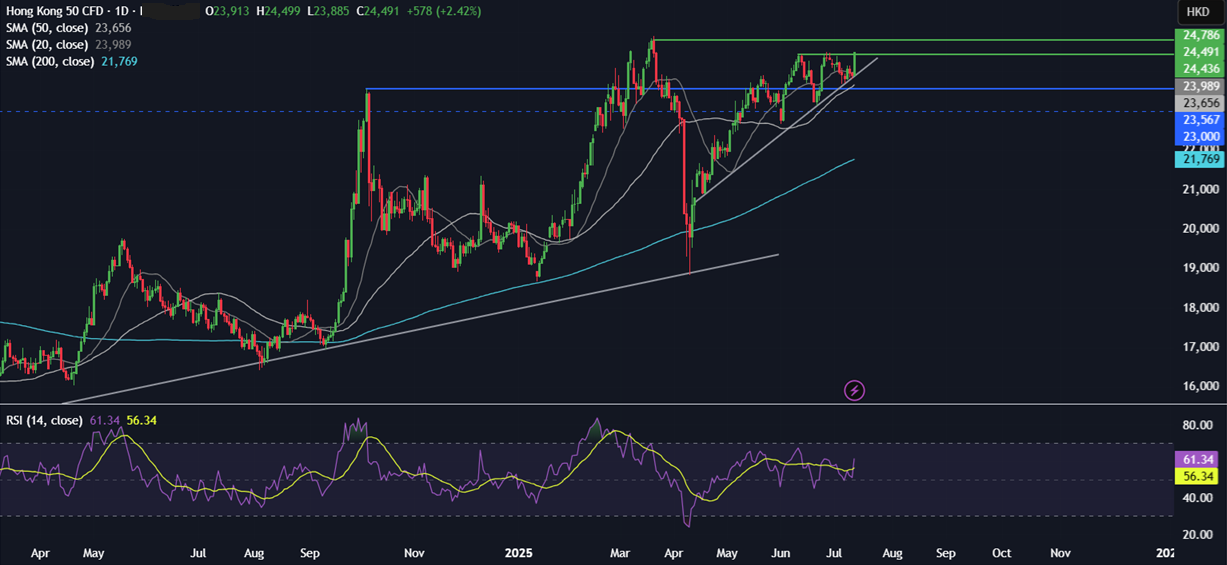
Canada CPI (Tuesday)
With the BoC on pause and avoiding forward guidance, the central bank is taking a meeting-by-meeting approach, owing to the economic uncertainty. This week’s inflation data will help drive expectations for BoC policy, with the money markets only pricing in one further 25 basis point reduction by the end of the year. In the latest BoC statement in June, policymakers highlighted that inflation had been slightly stronger than expected, whilst the core inflation measure had moved up. The statement also highlighted how households expect tariffs to increase prices, with many businesses saying they intend to pass on the costs of higher tariffs. At the end of last week, Trump announced a 30% trade tariff on Canada, which was higher than expected. The next BoC meeting is on July 30th, and this inflation print is unlikely to fuel a move by the BoC, which is likely to adopt a wait-and-see approach. The problem they face is that inflation could actually slow as a result of the tariffs, which will likely impact the labour market and economic growth. Weaker-than-forecast inflation could pull CAD lower and boost USD/CAD.
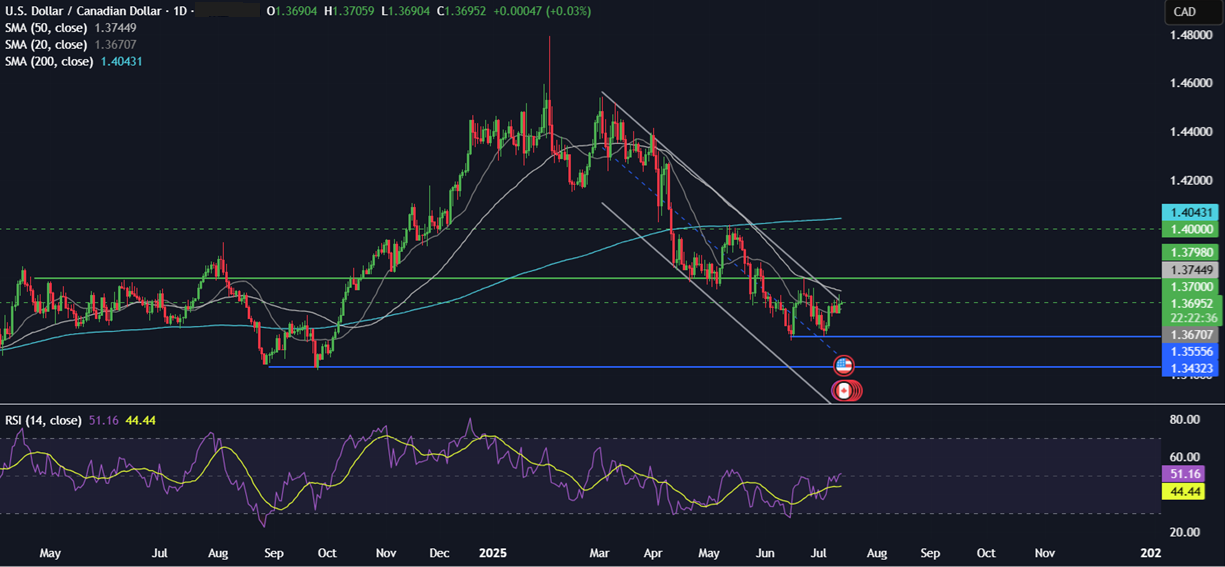
UK CPI (Wednesday)
UK CPI is expected to rise to 3.5% YoY in June, up from 3.4% in May. Core inflation is expected to remain at 3.5% in line with May’s report. Services inflation cooled by more than expected, easing to 4.7% down from 5.4% in May, and the market will be watching to see if that trend continues. Sticky service sector inflation has been an obstacle for the BoE to cut rates more aggressively. From a policy perspective, the data will likely highlight the ongoing challenge that the BoE faces with growth showing signs of slowing, UK GDP contracted -0.1% MoM in May, and as the job market slows, but as inflation remains stubborn. Hotter than expected CPI could boost GBP/USD.
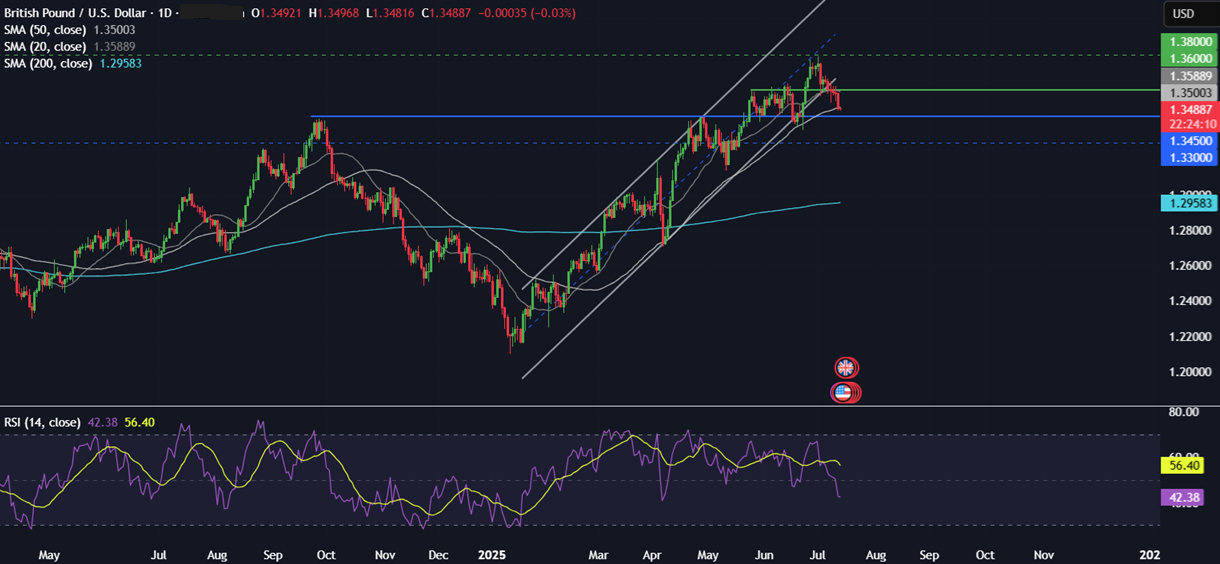
UK wages/unemployment (Thursday)
The impact of the government’s budget appears to be feeding through into UK job numbers. In April, the government’s increase in tax burden for employers came into effect; as a result, unemployment numbers edged up to 4.6% that month, the highest level since 2021. Since the budget was announced in October, unemployment has risen from 4% to 4.6%. The slowdown in the hiring trend shows signs of accelerating, with industry data pointing to falling payrolls. According to Statista, payrolls have been on the decline each month since November last year. As the labour market weakens, wage growth could also slow, which may accelerate the contraction in GDP and result in cooler inflation. Weak jobs data could dampen demand for the FTSE 100, which rose to a record high last week.
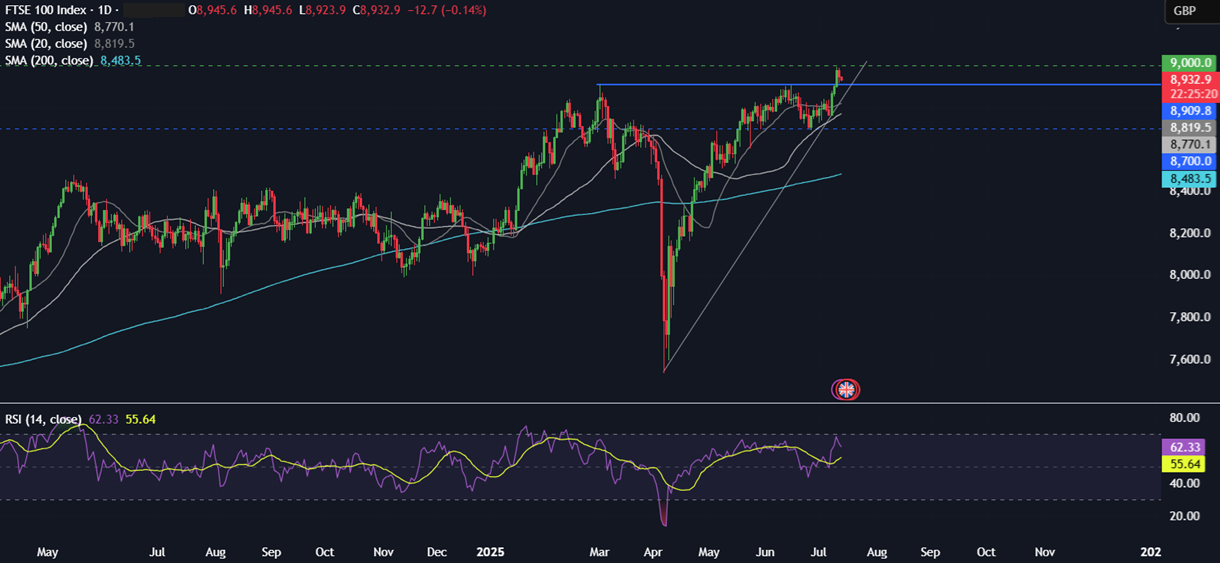
US retail sales (Thursday)
US retail sales are expected to remain unchanged in June, 0% month on month after falling 0.9% in May. Bank of America’s credit card data showed that credit and debit card spending per household rose 0.2% year on year in June after rising 0.8% year on year in May. There are signs that consumers are pulling back in some areas of discretionary spending, but this cooling doesn’t appear to be broad-based yet. Lower-income households ‘ spending growth is notably soft, and these households would see the weakest after-tax wage growth. For now, the resilient US labour market is supporting spending, but concerns over the outlook could hurt spending going forward. Weak retail sales could Worry investors, pulling the S&P 500 lower.
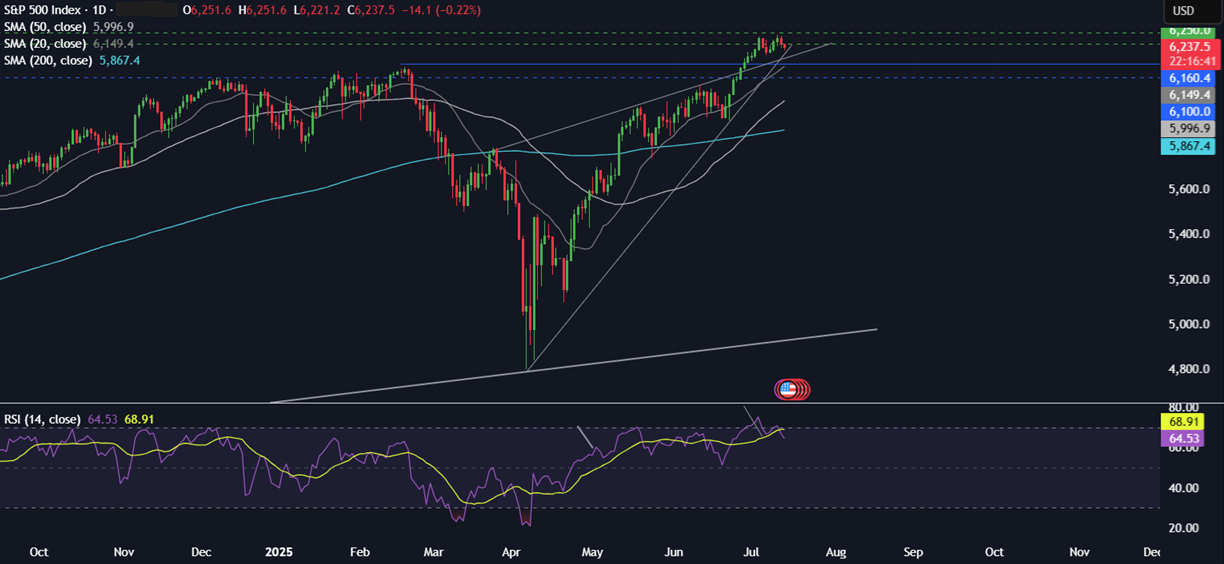
Japan CPI (Friday)
Japanese inflation in May rose 3.7% year on year to a more than two-year high and well above the 2% target. Expectations are that there could be a slight easing of inflationary pressures given government caps on energy and food prices, although headline CPI is expected to stay above 3%. Bank of Japan policymakers remain divided on the outlook for the economy and for interest rates, balancing upside inflation risks against headwinds from US tariffs. President Trump announced 25% trade tariffs on Japan last week, which are set to be implemented as of August 1st. The tariffs could slow the economy, pushing back BoJ rate hike expectations. Cooler CPI could dampen BoJ rate hike bets, JPY lower, boosting USD/JPY.
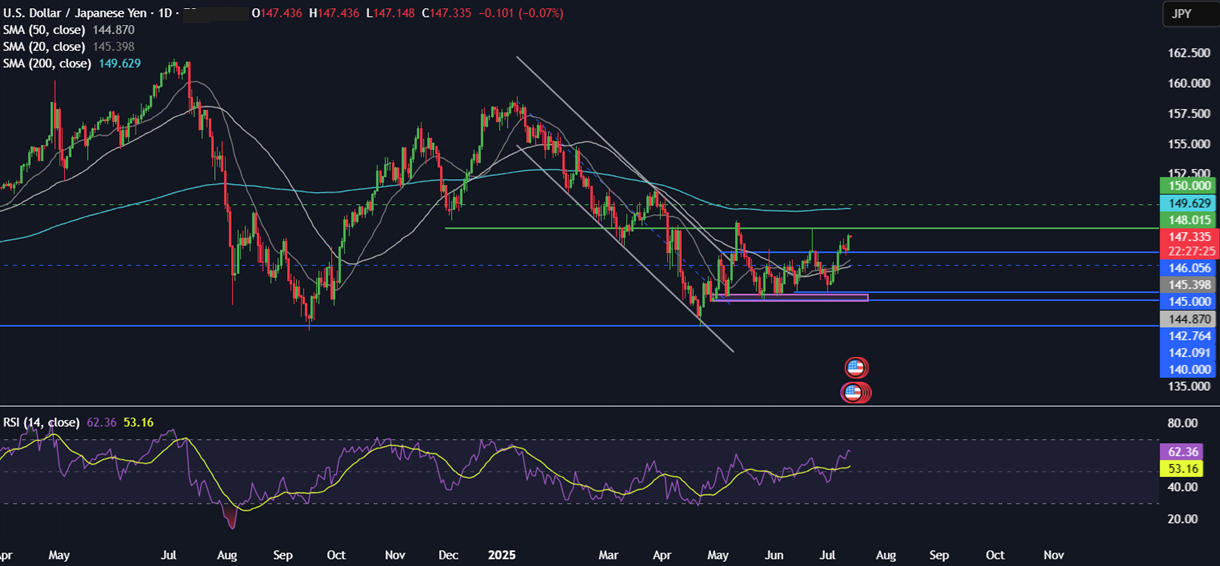
Trading involves risk.
The content provided here is for informational purposes only. It is not intended as personal investment advice and does not constitute a solicitation or invitation to engage in any financial transactions, investments, or related activities. Past performance is not a reliable indicator of future results.
The financial products offered by the Company are complex and come with a high risk of losing money rapidly due to leverage. These products may not be suitable for all investors. Before engaging, you should consider whether you understand how these leveraged products work and whether you can afford the high risk of losing your money.
The Company does not accept clients from the Restricted Jurisdictions as indicated in our website/ T&C. Some services or products may not be available in your jurisdiction.
The applicable legal entity and its respective products and services depend on the client’s country of residence and the entity with which the client has established a contractual relationship during registration.




